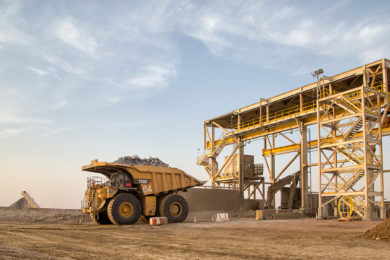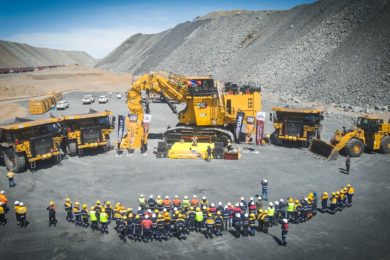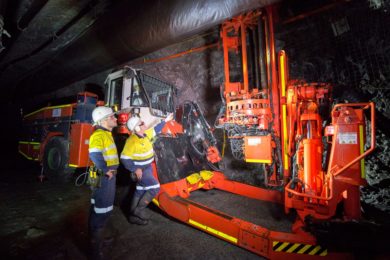The 100% Kinross owned world-class Tasiast gold mine in Mauritania is one of the jewels in the crown of African mining outside of southern Africa. The company has just hosted an analyst tour to the operation which has given some good insights into its status and expansion plans.
Tasiast is located in Inchiri, Mauritania within the Aouéouat greenstone belt. It currently has a 5.7 Moz proven & probable reserve, 1.5 Moz measured & indicated resource, plus 1.4 Moz inferred resource. It uses a conventional truck and shovel open-pit mining method, with carbon-in-leach processing. Commerical production began in 2008 by with mill and heap leach processing and the mine was then acquired by Kinross in September 2010 with its acquisition of Australia’s Red Back Mining.
Looking at the mine, West Branch (WB) is the primary operating pit. Within WB, Tasiast is presently mining the WB4 pit shell, with WB5 and WB6, and Piment still to be mined throughout the remaining life of mine. The current pit dimensions are 355 m deep, 1,500 m wide, and 2,000 m long. Ongoing WB5 stripping is critical to delivering high grade ore and securing production from the 2027 to 2029. WB4 mining will for now continue to deliver high grade ore to the mill until 2025. For the year to date in 2023, daily average total mined tonnes of have ranged from 175,000 to 225,000 t/d with monthly mined ore grade ranging from 2.6 to 3.5 g/t. The strip ratio is about 6:1.
The mining fleet consists of a large fleet of 45 Caterpillar 793 mining trucks, loaded by six mining face shovels – including older O&K RH340 models and their successor Caterpillar 6060 machines, one of which is a new model commissioned in June 2023. The mine also has two Cat 994 wheel loaders, other excavators and a large fleet of 12 blasthole drill rigs. A new Sandvik DI650i crawler drill was also commissioned in June this year.
The mine is also investing in the future, with six new Hitachi EH4000 trucks expected to be commissioned in 2024. Some 20 of the 793 trucks are to undergo planned capital rebuilds in 2023; the most in Tasiast history. Maintenance teams have also been focused on improving the overall performance and reliability of the 793 truck fleet. This fleet upgrading is all aimed at meeting expected mill demand at expanded throughput levels.
The Tasiast CIL plant consists of a SAG in closed circuit with a cyclone cluster. Cyclone overflow is pumped to two, parallel ball mills. The gravity circuit uses Knelson concentrators and Gekko ILRs to recover coarse gold. The leaching circuit comprises of five leach tanks and seven CIL (carbon in leach) tanks where dissolved gold is recovered on activated carbon. Tailings from the CIL plant are treated with a ferrous sulphate solution to detoxify the residual cyanide before being pumped to the TSF5 tailings storage facility. Stripping is performed with the Anglo American Research Laboratories (AARL) strip process. Gold is recovered from solution by electrowinning onto stainless steel wire wool cathodes prior to smelting the final doré bars.
Overall, three mill expansions have been completed to date, most recently the latest expansion is nearly complete to 24,000 t/d of milled tonnes. Phase one from 8,000 to 12,000 t/d was completed in 2018 then phase two part 1 from 12,000 to 21,000 was completed in 2022 followed by the current phase two part 2 from 21,000 to 24,000 t/d well underway and on track for sustained throughput at this level by year end.
Full year 2023 production is on plan, mill ramp up is progressing as planned and production remains on track to achieve full year guidance of 610,000 oz. Mill modifications are complete, with strong progress on throughput ramp up. The plant has already achieved throughput of 24,000 t/d for sustained periods of time, demonstrating the ability to achieve the expansion design levels. An average throughput of 20,000-21,000 t/d is expected through the remainder of 2023. The current focus is on sustaining higher throughput levels, optimising recoveries and building in mill resiliency.
There is also scope to extend the mine underground but the West Branch UG potential not included in current LOM plan. An underground study was completed by an independent consultant in 2021 based on the Inferred Resource. Six scenarios developed – three based on Longhole Open Stoping (LHOS) with unconsolidated rock fill and three based on Sub Level Caving (SLC), all with two ramps. The study envisages about 1 Moz of total production, based on 11-12 Mt of ore at ~2.5 g/t gold. In addition to West Branch, targets have been identified at Piment and Prolongation.
On tailings, there are three storage facilities on site of which two are at capacity, with one in operation. Tasiast is currently constructing the next raise (TSF 4/5 Raise 2) with the existing tailings capacity expected to last until Q1 2025. An additional storage facility is planned to supplement the remainder of LOM tailings. On power, there is currently installed capacity of 60 MW via a large Wartsila genset with construction of a 34 MW solar project on track for completion by year-end. Solar power is expected to reduce GHG emissions by 530 t and lower AISC by $15/oz for LOM.










